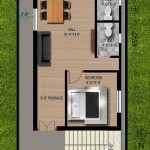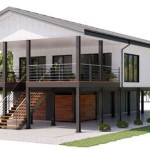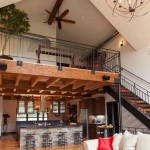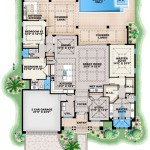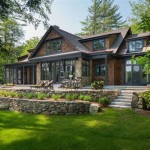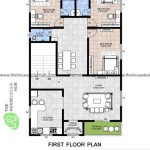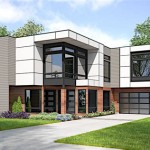Studio Apartment Floor Plan With Dimensions: A Comprehensive Guide
A studio apartment, characterized by its single main room encompassing living, sleeping, and dining areas, presents unique design challenges and opportunities. Understanding studio apartment floor plans, particularly in conjunction with their dimensions, is crucial for effective space planning, furniture selection, and overall livability. This article explores the intricacies of studio apartment floor plans with dimensions, focusing on key planning considerations, prevalent layouts, and methods for maximizing space utilization within these compact living environments.
The primary appeal of a studio apartment lies in its affordability and simplicity. Rent and utilities are typically lower compared to larger apartments, making it an attractive option for students, young professionals, and individuals seeking a minimalist lifestyle. However, the limited space necessitates careful planning to ensure functionality and comfort. A well-designed studio apartment can feel spacious and organized, while a poorly planned one can feel cramped and chaotic.
Dimensions play a pivotal role in determining the suitability of a studio apartment. While there is no standard size for a studio, most range from 300 to 600 square feet. Smaller studios, often referred to as micro-studios, may fall below 300 square feet. Understanding not only the total square footage but also the specific dimensions of each area within the apartment – length, width, and ceiling height – is essential for accurate furniture placement and space optimization. For example, a long and narrow studio will require a different approach compared to a more square-shaped layout.
Key Considerations in Studio Apartment Floor Plan Design
Several key considerations must be addressed when designing a studio apartment floor plan. These considerations are not merely aesthetic; they directly impact the usability and overall satisfaction of the living space. Thoughtful planning upfront minimizes compromises and maximises the potential of the studio.
Zoning: Perhaps the most critical aspect of studio design is zoning. Dividing the single room into distinct functional areas is paramount for creating a sense of order and separation. This can be achieved through various methods, including furniture placement, area rugs, screens, shelving units, and even changes in flooring. The aim is to visually and functionally delineate the sleeping zone from the living zone, and the dining zone from the kitchen area (if it is not already a separate room).
Effective zoning enhances the feeling of spaciousness and prevents the apartment from feeling like a single, cluttered room. Moreover, distinct zones offer a psychological benefit, allowing for a better sense of work-life balance and relaxation. For instance, a clearly defined sleeping area can promote better sleep hygiene compared to a bed placed directly within the living space.
Storage: Storage is a premium in any small space, but it is particularly crucial in a studio apartment. A lack of adequate storage leads to clutter, which quickly diminishes the appeal and functionality of the space. Therefore, integrating storage solutions into the floor plan is essential.
Vertical storage is a key strategy. Utilizing wall space with shelving units, tall cabinets, and even wall-mounted storage systems can significantly increase storage capacity without taking up valuable floor space. Multi-functional furniture, such as beds with built-in drawers or storage benches, offers discreet storage options that maximize utility. Careful consideration should also be given to optimizing closet space, often a limited resource in studio apartments. Organizers and shelving can transform a cramped closet into a highly efficient storage zone.
Light and Ventilation: Adequate light and ventilation are crucial for creating a comfortable and inviting living environment. Natural light makes a space feel larger and more airy, while good ventilation improves air quality and prevents the feeling of stagnation.
When assessing a studio apartment floor plan, pay close attention to the location and size of windows. Maximize natural light by keeping window treatments minimal and avoiding obstructing furniture. If the apartment lacks sufficient natural light, consider incorporating artificial lighting strategically. Layered lighting, including ambient, task, and accent lighting, can create a warm and inviting atmosphere. Good ventilation is equally important; ensure that the apartment has adequate airflow, especially in the kitchen and bathroom areas. Consider using exhaust fans to remove moisture and odors.
Common Studio Apartment Layouts
While the general principle of a studio apartment remains consistent – a single main room – variations in floor plans exist. These layouts influence the way the space is utilized and the types of furniture that will best suit the apartment. Understanding these common layouts allows for more informed decision-making when selecting a studio and devising a design plan.
Rectangular Layout: The rectangular layout is one of the most common studio apartment floor plans. This layout typically features a long and narrow space. Zoning in a rectangular studio can be achieved by dividing the space into distinct areas running lengthwise. For example, one end of the rectangle can be designated as the sleeping area, the middle as the living area, and the other end as the dining or workspace. Furniture should be selected carefully to avoid blocking the flow of movement and to maintain a sense of openness. Using rugs to define each zone can be a helpful visual tool.
Square Layout: A square layout offers more flexibility than a rectangular layout. The symmetrical nature of the space allows for a greater variety of furniture arrangements and zoning strategies. The sleeping area can be positioned in a corner, creating a cozy and private nook. The living area can be centered in the room, providing ample space for seating and entertainment. The key is to maintain a balance and avoid overcrowding the space.
L-Shaped Layout: The L-shaped layout offers a degree of natural separation, making zoning easier. The "L" shape creates two distinct areas that can be used to delineate the sleeping and living zones. One arm of the "L" can be dedicated to the sleeping area, while the other arm can serve as the living and dining space. This layout often provides a greater sense of privacy compared to rectangular or square studios.
Alcove Studio Layout: An alcove studio features a partially separated area, often labeled an alcove, that can be used for sleeping or as a dedicated workspace. The alcove provides a degree of privacy and visual separation without completely walling off the area. This layout offers a compromise between the openness of a traditional studio and the privacy of a one-bedroom apartment.
Maximizing Space Utilization in Studio Apartments
Given the limited square footage of studio apartments, maximizing space utilization is paramount. This involves employing strategic design choices, selecting multi-functional furniture, and embracing organizational techniques.
Multi-Functional Furniture: Incorporating multi-functional furniture is a cornerstone of effective studio apartment design. Sofa beds are a classic example, providing seating during the day and a comfortable sleeping surface at night. Storage ottomans offer both seating and storage solutions. Folding tables can be used for dining or as a workspace and then folded away when not in use. The key is to select furniture that serves multiple purposes, minimizing clutter and maximizing efficiency.
Vertical Space Optimization: Utilizing wall space is crucial for maximizing storage and creating a sense of spaciousness. Shelving units, wall-mounted cabinets, and even hanging organizers can significantly increase storage capacity without taking up valuable floor space. Consider installing shelves above doorways or utilizing the space above the bed for storage. Vertical space optimization is essential for keeping the floor clear and creating a more open feel.
Strategic Use of Mirrors: Mirrors are a powerful tool for enhancing the perception of space in a small apartment. A large mirror placed on a wall can create the illusion of greater depth and make the room feel larger. Mirrors also reflect light, brightening the space and making it feel more airy. Consider placing a mirror opposite a window to maximize the effect of natural light. Strategically placed mirrors can transform a cramped studio into a more open and inviting space.
Color Palette and Decor: The color palette and decor choices can significantly impact the feeling of spaciousness in a studio apartment. Lighter colors tend to make a space feel larger and brighter, while darker colors can make a room feel smaller and more enclosed. Consider using a light and neutral color palette for the walls and furniture, and then adding pops of color with accessories and artwork. Minimize clutter by keeping decor simple and intentional. A well-curated selection of accessories can add personality and style without overwhelming the space.
In summary, understanding studio apartment floor plans with dimensions is crucial for creating a functional and comfortable living space. By carefully considering zoning, storage, light, and ventilation, and by employing strategic design choices, it is possible to transform a small studio into a stylish and efficient home. Multi-functional furniture, vertical space optimization, strategic use of mirrors, and careful attention to color palette and decor are all essential tools for maximizing space utilization and creating a livable environment.

Architectural Floor Plan With Dimensions Studio Apartment Vector Ilration Top View Furniture Set Stock Of Flat Door 75623873

Studio Apartment Plan Examples

Studio Apartment Floor Plans Examples Design Steps Cedreo

Studio Apartment Plan Examples

Small Studio Apartment Floor Plan

Studio Apartments For In Lincoln Ne Wh Flats

Farnam Flats Has A Variety Of Floor Plan Options Available For
:strip_icc()/cdn.cliqueinc.com__cache__posts__209346__how-to-lay-out-a-studio-apartment-and-have-room-to-spare-1989064-1479848042.700x0c-44608818a5464e0b8a2bf96fd542ae28.jpg?strip=all)
One Studio Apartment 4 Ways Follow Our Stylish Guide

Floor Plan Of Examined Apartments A Studio B One Bedroom And C Scientific Diagram

Studio Apartment Floor Plans
Related Posts

